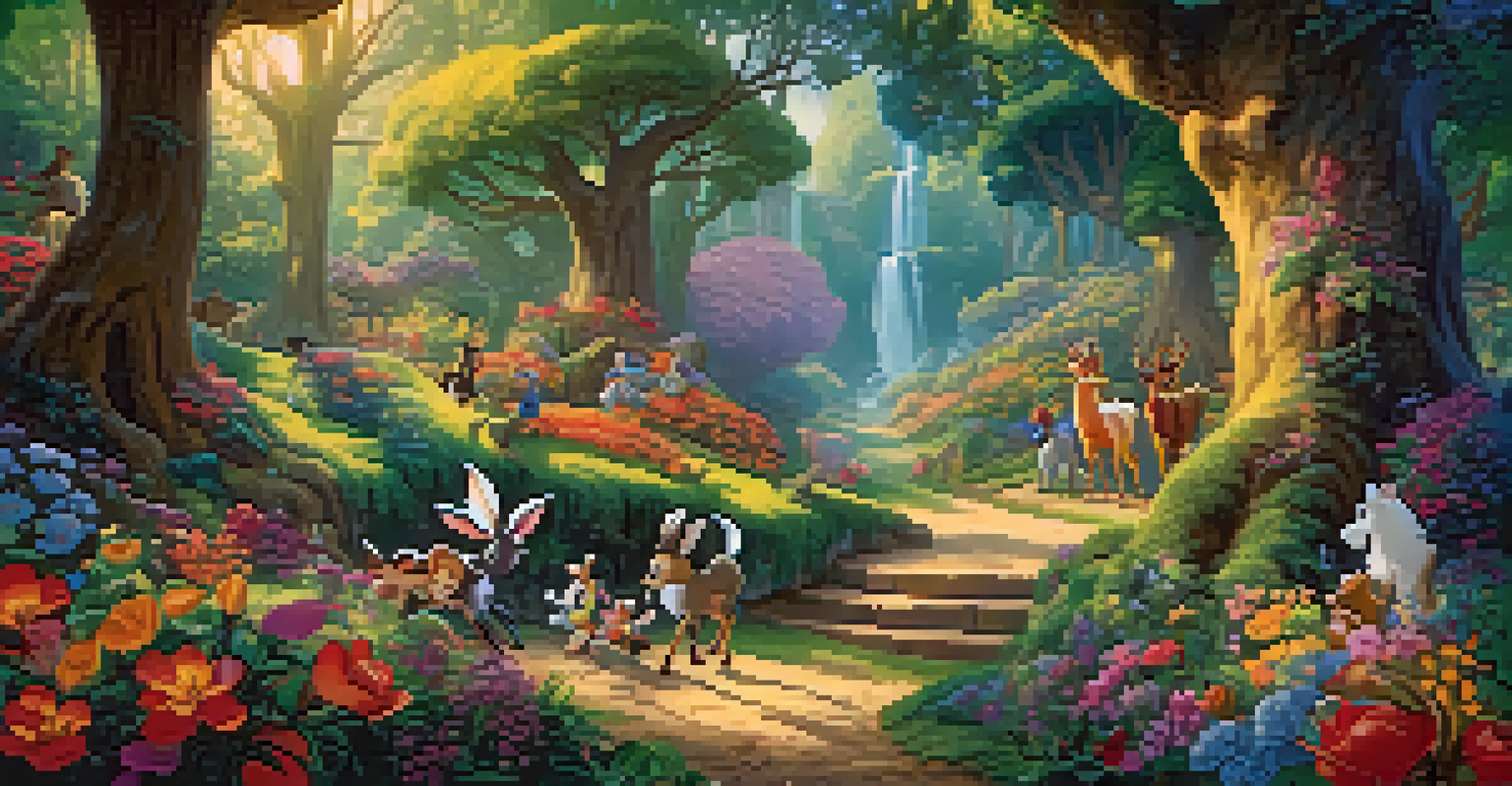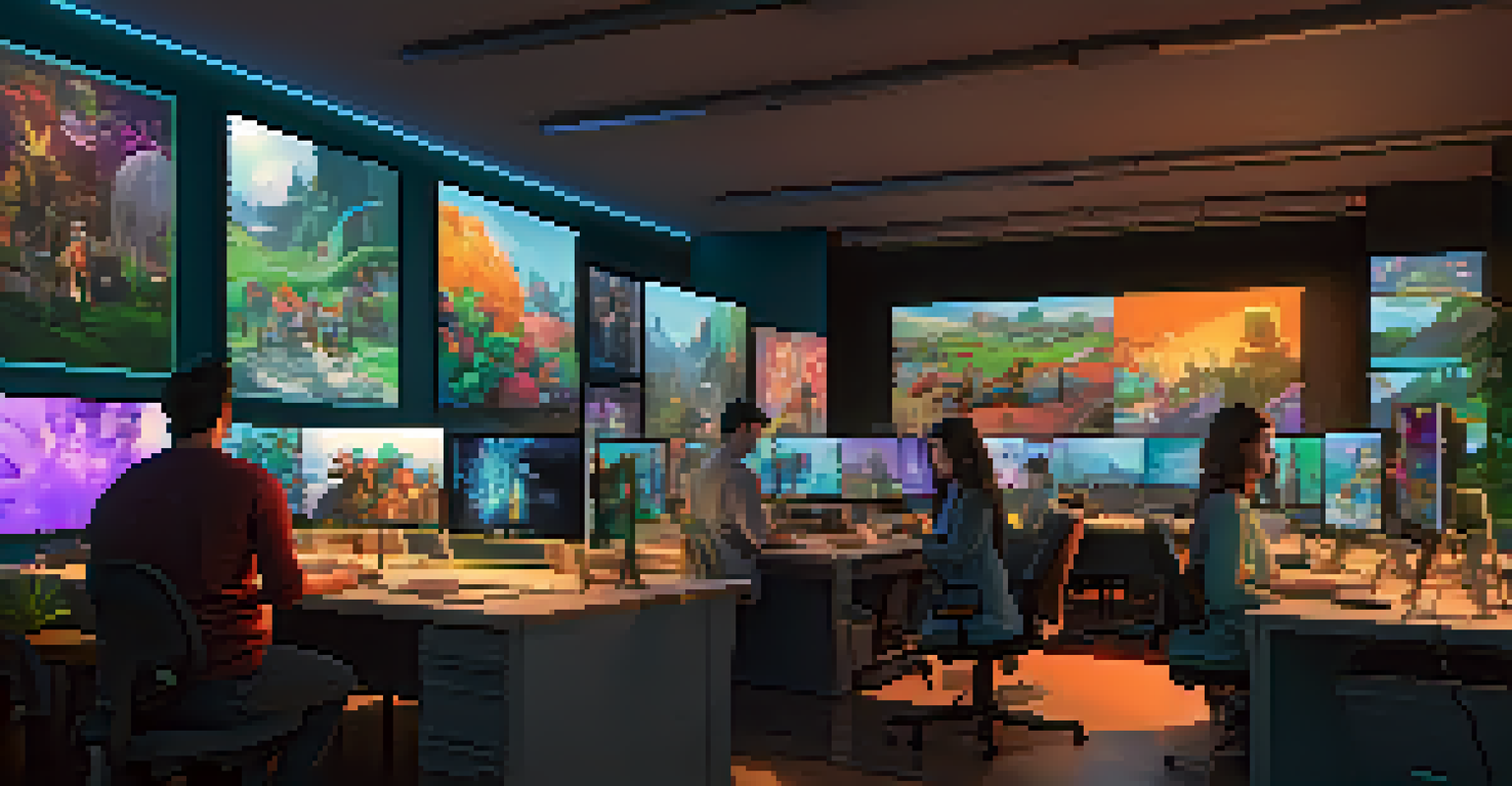The Evolution of Animation: Hollywood's Creative Transformation

The Birth of Animation: Early Beginnings in Hollywood
Animation, as we know it today, began to take shape in the early 20th century. Pioneers like Winsor McCay created groundbreaking works, such as 'Gertie the Dinosaur,' which captivated audiences with its fluid movement. This era marked the transition from static images to dynamic storytelling, laying the groundwork for future innovations.
Animation can explain whatever the mind of man can conceive.
These initial experiments were simple, yet they sparked a creative revolution. The ability to bring drawings to life opened up new avenues for storytelling, allowing animators to explore themes and characters in ways that live-action films could not. The imagination of these early artists paved the way for a new form of entertainment.
As the demand for animated content grew, studios like Walt Disney Productions began to emerge, leading to a golden age of animation. This period not only showcased technical advancements but also highlighted the importance of narrative, setting the stage for animation’s evolution in Hollywood.
The Golden Age: Disney and the Rise of Feature Animation
The Golden Age of Animation, spanning the 1930s to the 1960s, was largely defined by Disney's iconic films. Classics like 'Snow White and the Seven Dwarfs' showcased not only stunning animation but also compelling storytelling that appealed to audiences of all ages. This era set the standard for feature-length animated films, combining artistry with emotional depth.

Disney’s success encouraged other studios to invest in animation, leading to a surge in creativity and competition. Films like 'Bambi' and 'Cinderella' expanded the possibilities of animated storytelling, infusing rich narratives with memorable characters. The enchanting worlds created during this time still resonate with audiences today.
Animation's Evolution Through Eras
From early pioneers to the Disney Renaissance, animation has transformed significantly, adapting to technological advancements and storytelling techniques.
The innovations of this period, including advancements in sound and color technology, transformed animation into a respected art form. This evolution not only changed how stories were told but also established animation as a vital component of Hollywood, influencing generations of creators.
The Renaissance: A New Wave of Creativity in Animation
The late 1980s to the mid-1990s marked the Disney Renaissance, a period characterized by a revival in animated feature films. Hits like 'The Little Mermaid' and 'The Lion King' redefined animation, blending memorable music with captivating stories. This era reignited interest in animation, proving that it could deliver emotional and impactful narratives.
The only limit to your impact is your imagination and commitment.
During this time, studios began to embrace diverse storytelling styles and genres, pushing the boundaries of traditional animation. This creative freedom allowed filmmakers to explore more complex themes and characters, resonating with both children and adults. The blend of humor and heart became a hallmark of this transformative era.
The success of these films encouraged animated features to break into the mainstream, inspiring a new generation of animators. This resurgence also led to the emergence of other studios, such as Pixar, which introduced groundbreaking computer-generated animation, forever changing the landscape of the industry.
The Digital Revolution: Animation Meets Technology
As technology advanced, so did animation techniques, leading to the digital revolution in the late 1990s. With the advent of computer-generated imagery (CGI), films like 'Toy Story' showcased the potential of digital animation, changing the way stories were visualized. This shift not only enhanced visual effects but also opened doors for new creative possibilities.
Digital animation allowed filmmakers to create intricate worlds and characters with unprecedented detail. The ability to manipulate images with software provided animators the freedom to explore unique storytelling methods, leading to visually stunning films that captivated audiences worldwide. This technological leap transformed the animation process, making it more efficient and versatile.
Diversity Enhances Animation Stories
Recent films like 'Coco' and 'Moana' highlight the industry's commitment to inclusivity, enriching the medium with diverse cultural narratives.
The impact of this digital shift was profound, leading to a surge in animated films and series across various platforms. Streaming services began to embrace animation, resulting in a diverse array of content that appealed to different demographics, further solidifying animation’s place in modern entertainment.
Diversity in Animation: Expanding Voices and Stories
In recent years, the animation industry has made significant strides toward embracing diversity, both in storytelling and representation. Films like 'Coco' and 'Moana' celebrate cultural narratives and traditions, allowing audiences to connect with stories from around the globe. This focus on inclusivity enriches the medium, offering a broader spectrum of experiences.
Moreover, the rise of independent animation has allowed for even more unique voices to emerge within the industry. Creators are exploring unconventional themes and styles, showcasing the versatility of animation as a storytelling medium. This shift encourages innovation and challenges traditional norms, appealing to a more diverse audience.
As the demand for authentic representation continues to grow, the animation landscape is evolving to reflect the world around us. This transformation not only enriches the stories told but also fosters a deeper connection between filmmakers and audiences, highlighting the importance of diverse perspectives in creative storytelling.
Animation in the Era of Streaming: New Opportunities
The rise of streaming services has revolutionized the animation industry, offering new opportunities for creators and audiences alike. Platforms like Netflix and Disney+ have embraced animated content, producing original series and films that cater to diverse tastes. This shift has made animation more accessible, allowing creators to reach wider audiences without the constraints of traditional media.
Additionally, streaming has enabled a surge in animated series aimed at adults, breaking the stereotype that animation is solely for children. Shows like 'Bojack Horseman' and 'Big Mouth' tackle complex themes with humor and depth, showcasing the versatility of animation across different age groups. This evolution has opened the door for innovative storytelling that resonates with a broader demographic.
Streaming Revolutionizes Animation
The rise of streaming services has expanded opportunities for animated content, allowing creators to reach broader audiences with innovative storytelling.
As streaming continues to shape the future of animation, it also encourages experimentation and risk-taking. The landscape is now filled with diverse narratives that push creative boundaries, ensuring that animation remains a dynamic and essential part of modern entertainment.
The Future of Animation: Trends and Innovations
Looking ahead, the future of animation appears bright, with ongoing advancements in technology and storytelling techniques. Emerging technologies, like virtual reality (VR) and augmented reality (AR), are beginning to influence how stories are told, offering immersive experiences that engage audiences on a new level. This evolution promises to reshape the animation landscape as creators explore new ways to captivate viewers.
Moreover, there’s a growing emphasis on sustainability in animation production, reflecting a broader trend in the entertainment industry. As studios become more aware of their environmental impact, eco-friendly practices are being integrated into the animation process. This commitment to sustainability not only benefits the planet but also resonates with a socially conscious audience.

With an ever-expanding array of platforms and technologies, the animation industry is poised for continued growth and transformation. As creators embrace new tools and diverse narratives, the art of animation will undoubtedly evolve, ensuring it remains a vital and beloved part of storytelling for generations to come.